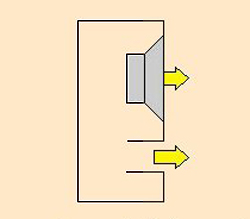Vented-box woofers are boxes with one or more speakers mounted in them, and one or more holes or ducts leading from the inside of the box to the outside.
A vented-box woofer is acoustically equivalent to a loudspeaker mounted in the bottom of a Coke bottle.
At the bottle’s resonant frequency (what you hear when you blow across its mouth), the speaker doesn’t have to work much – the air in the bottle does the work.
What designers do is to position the bottle’s resonant frequency at the lower end of the range, right down where the speaker is about to run out of gas. The port takes over, making the bass go louder and lower.
Vented-box woofers are also called Helmholtz Resonators, Ported Boxes, Bass-Reflex Boxes, other things. A variant of the design uses a passive radiator instead of a port.
Passive radiators are loosely suspended diaphragms that act the same as ports for acoustical purposes.
The good things about vented-box woofers include:
• Relatively compact size and modest weight.
• Fairly easy to design.
• May be built in a variety of shapes and proportions.
• Relatively easy and inexpensive to construct.
• May be used singly or in arrays of almost any shape.
• Relatively good frequency response well up into midbass range, allowing flexible selection of crossover frequencies.
• Well understood in the marketplace.
Some potential downsides of vented-box woofers are:
• For many designs, air turbulence in the port at high power produces high distortion, compression, and spurious noise.
The cure for this is to make the port very large and very long, but for many combinations of box size, power level, and frequency response required port shapes are impractical or even impossible.
• The efficiency of vented boxes is lower than that of the other concert woofer designs listed above, so you need more boxes and more amplifier watts.
• In some regions of their working frequency ranges, vented boxes require loudspeaker cones to move farther than some of the other designs.
The cone travel is short (nearly zero) near the port tuning frequency, but quite large about an octave above. Building loudspeakers for long cone travel is difficult, if you want to minimize distortion and compression at high power.
• Many designs require relatively long ducts on the ports. Long ports often have severe resonances (called “organ-pipe” resonances) in the 400 to 1500 Hz range. These resonances, if not suppressed, cause midrange coloration.
This coloration is a problem even if the box is crossed over at frequencies well below 400 Hz, because woofer distortion harmonics still excite the resonances. Also, where midrange speakers are nearby, the midrange energy in the air will cause the resonances to ring and color the sound.
This sounds like a small problem, but in practice it can be quite odious to deal with. If you’re the sound mixer, it feels as though you have peaking and ringing that you can’t remove with equalization, no matter what you try.
Despite these issues, the vented box remains the design of choice for many systems. The design is simple, the boxes are easy to use, and, if you don’t want really high power or really hi fi, they work quite well. When space is scarce, they’re often the only practical choice.
Jeff Berryman served as the director of Jasonaudio, a touring sound company based in Canada, and is a senior scientist with Electro-Voice.















